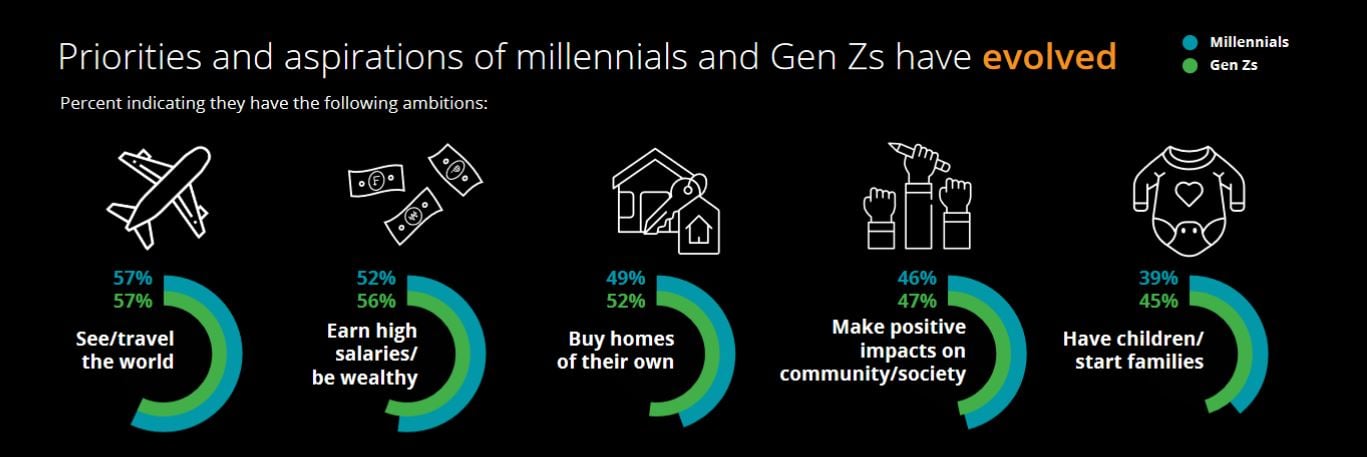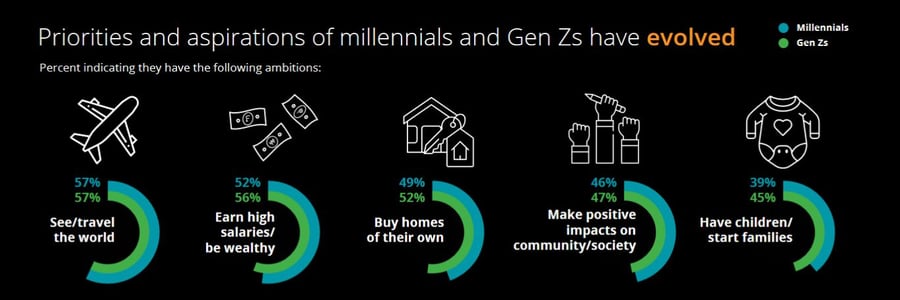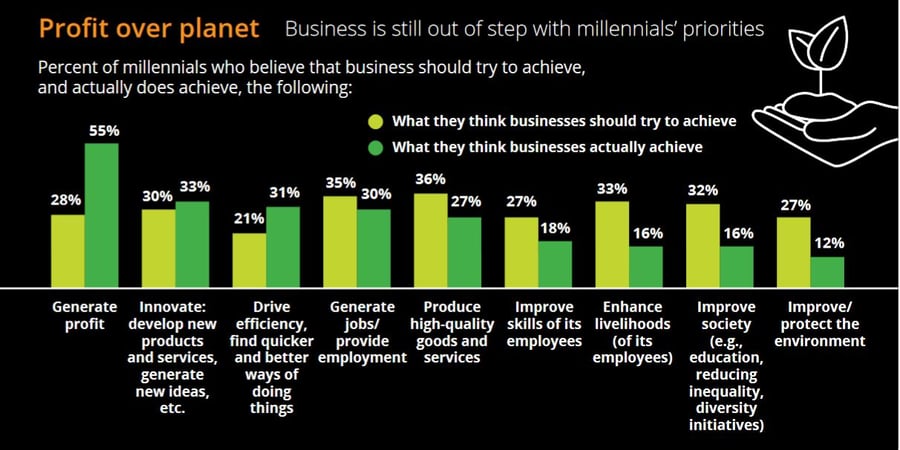
In the first installment of this series, I presented some sobering information about how members of the millennial generation view leadership traits and how their priorities are changing the dynamic of the American workplace. Most notably, while earning potential is important, the almighty dollar is no longer the sole driver of millennial career decision making, which represents a significant departure from almost every other generation of Americans that have come before them.
Indeed, the “American dream” is being redefined not by access to material wealth, but to quality of life that places a higher value on time and striking an acceptable work/life balance. In the quest to find this balance, millennials are job hopping more than any generation before them.
A Deloitte survey found that that just 28% of millennials plan to stay at their current jobs beyond five years, which creates tremendous challenges and adds significant costs for employers. However, “work/life balance” is a new, nebulous term in the workplace. Before conjuring up images of a Silicon Valley tech firm that offers ping-pong tables and napping rooms as employee perks, my research suggests that these incentives are short-term attempts at treating the symptoms, rather than addressing the underlying problem, associated with employee flight.
Per an examination by Harvard Extension School and Peter J. Martel, senior talent development consultant at Harvard Business School, the solution is actually much simpler than a limitless stream of trendy benefits. While consulting on human capital for a private firm in New York, Martel admitted that “Clients lamented issues like high turnover, typically specifying salary as the culprit. ‘But if they let us dig a little deeper, we almost always found that compensation wasn’t the issue. It was the red herring,’ he says.”
Rather, the genesis of the problem was typically low employee engagement and a resulting frustration with workplace management. “We’d have to tell them, ‘The real issue is that your people hate their jobs and they hate coming to work every day,’” Martel says.
How prevalent is the problem of disengagement? A Gallup study found that only 13% of employees worldwide are engaged at work, which equates to about one in eight workers who are “psychologically committed to their jobs and likely to be making positive contributions to their organizations. The bulk of employees worldwide - 63% - are ‘not engaged,’ meaning they lack motivation and are less likely to invest discretionary effort in organizational goals or outcomes.”
 Source: The Deloitte Global Millennial Survey 2019
Source: The Deloitte Global Millennial Survey 2019
Martel notes that while competitive compensation certainly plays a role, organizations must consider a more holistic approach to retaining talent, especially younger employees. Harvard Extension School says that “Investing in training and providing the resources for personal development go a long way in terms of employee engagement,” and employee engagement drives growth. A separate Gallup report notes that businesses with highly-engaged teams increase profitability by 21%, sales productivity by 20% and output quality by 40%, while decreasing workplace absences by 41%.
Increasing Engagement
“If employers really want to be high-performance organizations, their compensation and work systems need to be in sync with a commitment to having an engaged workforce. They need to have all the moving parts working together,” Martel adds. Managers and organizational leaders must be on board with the process of increasing engagement, and they must develop a proactive rather than reactive approach to awareness around the topic. “All of the research I’ve seen over the years about employee engagement really points, first and foremost, to the relationship with one’s immediate supervisor,” he says, adding that people who are unhappy with their manager most often choose to simply walk away from the job and company altogether.
A degree of natural turnover or “churn” in the workplace can be a good thing, as it allows top performers to set department benchmarks that will help younger new hires to rise and stretch for the organization. This is why effective leaders are imperative, and “organizations should help high performers develop leadership skills early on. According to Martel, the benefit of establishing ongoing leadership training is two-fold: employees will transition into senior positions with more ease, and they’ll be equipped to provide peer-to-peer coaching on their way up.”
Potential Solutions for Retaining Millennial Employees
The difficult first step towards increasing employee engagement is addressing the challenges of departmental “silos” and knowledge sharing in the workplace. In many sectors of the forest products industry, this can be difficult since a significant portion of the work is physical in nature. However, it is not altogether impossible.
A 2017 Forbes article covering leadership strategy provides a very concise 5-step process to improving employee engagement in the workplace, and the process can be duplicated regardless of organization size.
- “Step 1: Put Everyone in the Right Role. Get the right people on the bus and make sure they are in the right roles. This means that all talent acquisition and retention strategies have to be aligned with meeting company goals.
- Step 2: Give Them the Training. No manager or leader can expect to build a culture of trust and accountability — and much less improve engagement — without setting the team up for success. This means providing the proper training and development while removing obstacles.
- Step 3: Task Meaningful Work. Engaged employees are doing meaningful work and have a clear understanding of how they contribute to the company’s mission, purpose and strategic objectives. Again, this is why they first have to be placed in the right role. If you don’t sort those details out quickly, they will leave.
- Step 4: Check in Often. The days of simply relying on mid-year reviews for providing feedback are long gone. Today’s workforce craves regular feedback — which of course leads to faster course correction and reduces waste. Use both formal and informal check-in strategies — and use them every week.
- Step 5: Frequently Discuss Engagement. Successful managers are transparent in their approach to improving engagement — they talk about it with their teams all the time. They hold ‘state of engagement’ meetings and ‘engage’ everyone in the discussion — and solutions.”
Step 5 above is a good way to encourage “buy-in” and involve all employees in decision-making processes, but there are other creative ways to foster employer/employee relationships with younger workers that cost next to nothing and will have positive, encouraging effects in the organization.
- Cater to digital habits. Millennials value access to technology and companies that are in touch with these needs will be more attractive to them. In the workplace, nearly 50% of millennials believe new technologies will augment their jobs.
- Give them a reason to return. Recruiters that hire seasonal workers try to rely on the “boomerang” tactic, which means that employees often want to return to work for companies that provide them with a great experience—even when the work is temporary. When an employee leaves, many managers are quick to simply write them off. However, in a tight labor market where competition is intense and talent is difficult to find, maintaining relationships with employees who voluntarily left (for any reason) is a unique recruiting strategy that could benefit some sectors of the forest industry.
- Focus on wellbeing: Regardless of industry or rank, American workers are dealing with unprecedented levels of stress that impact productivity, health, home and workplace stability and, by extension, company performance. Hourly employees often experience stress due to scheduling conflicts and inflexibility, while salaried employees feel stress when they are unable to disconnect from their jobs. The negative effects of stress lead to increased absenteeism, disengagement and eventually job turnover, all of which impact profitability.
Organizations that focus on comprehensive wellbeing and encourage a fair work/life balance are much more attractive to younger workers. When Millennials believe their company has a high-trust culture, they’re 22 times more likely to want to work there for a long time. (In comparison, Gen Xers are 16 times more likely to want to stay, and Baby Boomers are 13 times more likely.)
- Prioritize a holistic company vision over profits. This seems counterintuitive to members of older generations, because money has always made the world go ‘round; businesses must be profitable to remain sustainable. However, younger generations are developing corporate expectations that must align with profits. The Deloitte Global Millennial Survey 2019 says “They let their wallets do the talking (and walking). Millennials and Gen Zs, in general, will patronize and support companies that align with their values; many say they will not hesitate to lessen or end relationships when they disagree with companies’ business practices, values, or political leaning.”
Deloitte research from 2018 notes that, “While your workers believe that business should consider stakeholders’ interests as well as profits, their experience is of employers prioritizing the bottom line above workers, society and the environment, leaving them with little sense of loyalty.” Millennials are inherently distrustful of profit-driven organizations, and the statistics confirm the trend.
- Just 55% believe business has a positive impact on wider society.
- 76% believe that businesses focus on their own agendas rather than considering wider society.
- 64% believe businesses have no ambition beyond wanting to make money.
- Millennials believe businesses are not enhancing employees’ livelihoods (33% said this is a priority; 16% said business achieves this), improving society (32% vs. 16%), and improving and protecting the environment (27% vs. 12%).

Source: The Deloitte Global Millennial Survey 2019
- Don't assume employees are happy. The squeaky wheel always gets the grease. However, watching talented, productive employees walk out the door because you presumed they were content is a costly mistake. Rather than making assumptions about the work environment you are responsible for establishing and maintaining, create a high-feedback environment that solicits honest input and collaboration. Empower your employees to openly contribute and encourage honest conversation and feedback, which will cultivate employee engagement at all levels of the organization.
As more baby boomers reach retirement age and phase out of the workforce, industries that are lacking millennials will need to be more creative when it comes to attracting and retaining new talent. Remember, it’s not solely about dollars anymore. Incorporating new management strategies and finding creative ways to develop new leaders is a process that takes time. However, fostering that process is imperative for businesses that want to remain profitable in a rapidly evolving economy.
As I stated in the first piece on this topic, I believe members of each generation are pursuing the same dreams; we all essentially want the same things in life, regardless of our age. But there are inevitable shifts as societies grow and progress that oftentimes force a reexamination of priorities, and we happen to be living squarely in one such period at this moment in time. Business leaders must acknowledge this reality and adapt accordingly, or they will find themselves in an even more challenging situation down the road. As retired US Army General Eric Shinseki remarked, “If you don’t like change, you’re going to like irrelevance even less.”





